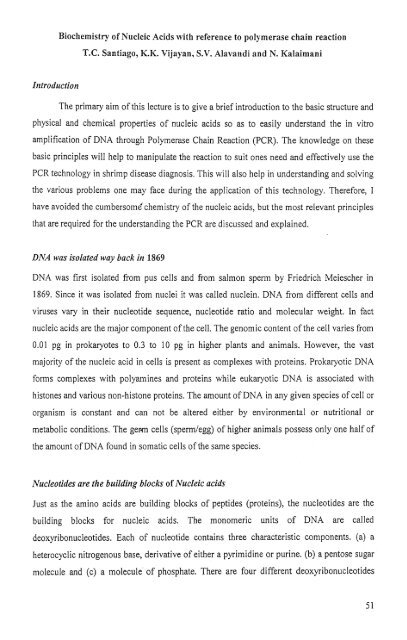, Diagnosis an-&& of Shrimp Diseases - Central Institute of ...
, Diagnosis an-&& of Shrimp Diseases - Central Institute of ...
, Diagnosis an-&& of Shrimp Diseases - Central Institute of ...
- No tags were found...
You also want an ePaper? Increase the reach of your titles
YUMPU automatically turns print PDFs into web optimized ePapers that Google loves.
Biochemistry <strong>of</strong> Nucleic Acids with reference to polymerase chain reactior~T.C. S<strong>an</strong>tiago, K.K. Vijay<strong>an</strong>, S.V. Alav<strong>an</strong>di <strong>an</strong>d N. Kalaim<strong>an</strong>lThe primary aim <strong>of</strong> this lecture is to give a brief introduction to the basic structure <strong>an</strong>dphysical <strong>an</strong>d chemical properties <strong>of</strong> nucleic acids so as to easily underst<strong>an</strong>d the in vitroamplification <strong>of</strong> DNA through Polymerase Chain Reaction (PCR). The knowledge on thesebasic principles will help to m<strong>an</strong>ipulate the reaction to suit ones need <strong>an</strong>d effectively use thePCR technology in shrimp disease diagnosis. This will also help in underst<strong>an</strong>ding <strong>an</strong>d solvingthe variot~s problems one may face during the application <strong>of</strong> this technology. Therefore, Ihave avoided the c~11nberson-16 chemistry <strong>of</strong> the nucleic acids, but the most reiev<strong>an</strong>t principlesthat are required for the underst<strong>an</strong>ding the PCR are discussed <strong>an</strong>d explained.DNA was isolated way back in 1869DNA was first isolated from pus cells <strong>an</strong>d from salmon sperm by Friedrich Meiescher in1869. Since it was isolated from nuclei it was called nuclein. DNA from different cells <strong>an</strong>dviruses vary in their nucleotide sequence, nucleotide ratio <strong>an</strong>d molecular weight. In factnucleic acids are the major component <strong>of</strong> the cell. The genomic content <strong>of</strong> the cell varies from0.01 pg in prokaryotes to 0.3 to 10 pg in higher pl<strong>an</strong>ts <strong>an</strong>d <strong>an</strong>imals. However, the vastmajority <strong>of</strong> the nucleic acid in cells is present as complexes with proteins. Prokaryotic DNAforms complexes with polyami~les <strong>an</strong>d proteins while eukaryotic DNA is associated withhistones <strong>an</strong>d various non-histone proteins. The amount <strong>of</strong> DNA in <strong>an</strong>y given species <strong>of</strong> cell ororg<strong>an</strong>ism is const<strong>an</strong>t <strong>an</strong>d c<strong>an</strong> not be altered either by environmental or nutritional ormetabolic conditions. The germ cells (spermfegg) <strong>of</strong> higher <strong>an</strong>imals possess only one half <strong>of</strong>the amount <strong>of</strong> DNA found in somatic cells <strong>of</strong> the same species.Nucleotides are the building blocks <strong>of</strong> Nucleic acidsJust as the amino acids are building blocks <strong>of</strong> peptides (proteins), the nucleotides are thebuilding blocks for nucleic acids. The monomeric units <strong>of</strong> DNA are calleddeoxyribonucleotides. Each <strong>of</strong> nucleotide contains three characteristic components. (a) aheterocyclic nitrogenous base, derivative <strong>of</strong> either a pyrimidine or purine. (b) a pentose sugar~nolecule <strong>an</strong>d (c) a molecule <strong>of</strong> phosphate. There are four different deoxyribonucleotides
















